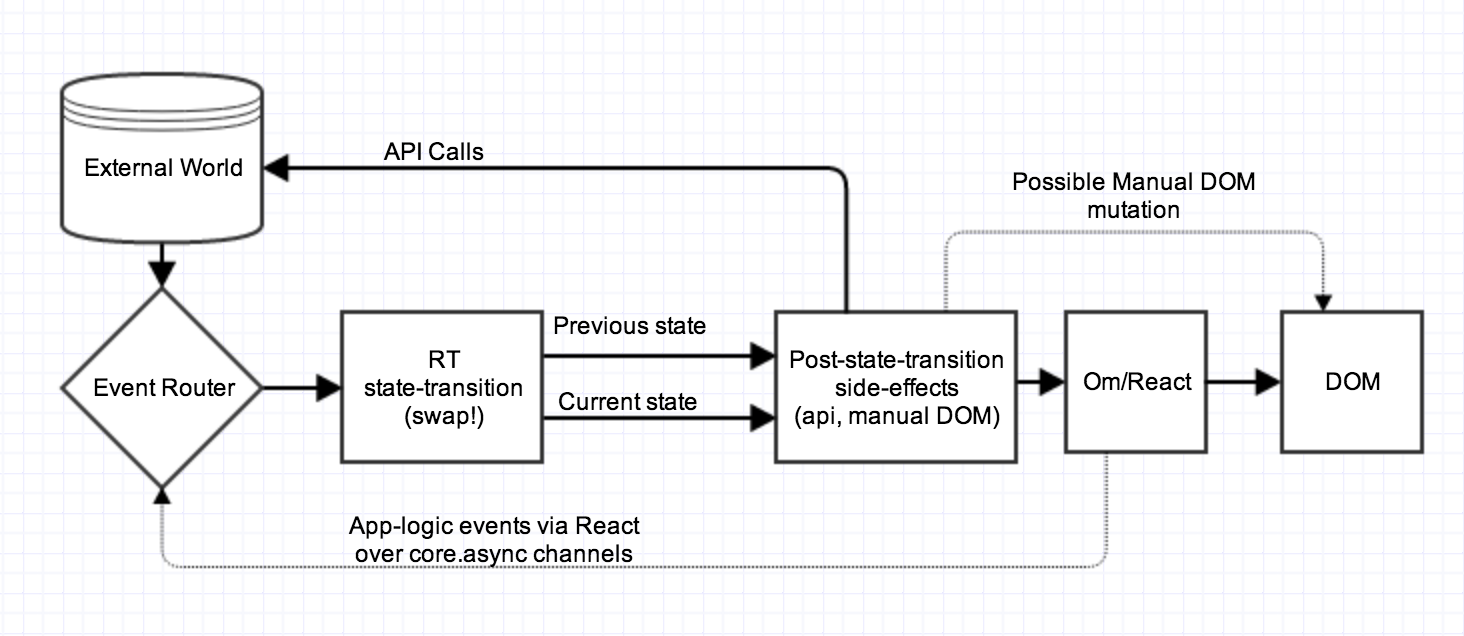React, Om, ClojureScript
Sean Grove
sean@bushi.do
Table of Contents
Browser-UI Challenges
- Performance
- Hand-tweaked optimizations
- Uncontrolled mutations
- Reuse, Sharing
- Complexity
- Scattered state
- Uncontrolled mutations
Om Intro
Thin(ish) wrapper around React
- ~930 LoC
- ~800 LoC if we're being fair
Referentially Transparent UI
- All app state stored in a single reference:
1: (def app-state 2: (atom {:navbar-expanded? false 3: :search-field "example" 4: :user {:id 10 5: :name "Natsume Soseki"}}))
- And then passed to user-defined components
1: (ns om-intro.components 2: (:require [om.core :as om] 3: [om.dom :as dom])) 4: 5: (defn comment-box [app] 6: (om/component 7: (dom/div #js {:className "comment-box"} 8: (dom/h1 nil "Leave a comment") 9: (dom/h3 nil (get-in app [:user :name])) 10: (dom/text {:id "new-comment"})))) 11: 12: (om/root 13: comments-box app-state 14: {:target (sel1 :#comments-container)})
- UI is then derived from the app state
- The same state will always produce the same UI
1-way Data-flow
(om/build comments-box app-state)
1: <div id='comments-container'> 2: <div class='comment-box'> 3: <h1>Leave a comment</h1> 4: <h3>Natsume Soseki</h3> 5: <textarea id='new-comment' /> 6: </div> 7: </div>
Mutate the state to trigger a re-render
(swap! app-state assoc-in [:user :name] "Mikhail Bulgakov")
1: <div id='comments-container'> 2: <div class='comment-box'> 3: <h1>Leave a comment</h1> 4: <h3>Mikhail Bulgakov</h3> 5: <textarea id='new-comment' /> 6: </div> 7: </div>
Performance
Cursors
Laziest hard-working library:
- State is managed via cursors
- A way of minimizing external world a function/component has to know about
- Think update-in: takes a path and a function, function only knows about terminal data, update-in translates diff back into origin data structure
- Cursors wrap normal data structures, remember their path in a 'parent' data structure
- Used along with components to determine which components need to be recalculated
- A way of minimizing external world a function/component has to know about
- Uses Clojure's immutable data-structures + cursors to determine if any path has changed via reference-equality check
- "Can determine changed paths, starting from the root, in logarithmic time"
- No state change, no re-render
- After state change, changed paths in state are compared with dependencies in components
- Dirty components are re-rendered (to virtual-dom)
- Minimizes React reconcilation work
- Even after state change and virtual-dom re-render, never re-renders actual DOM immediately. Schedules updates via requestAnimationFrame()
Consistency
- Om avoids many concurrency issues by forcing consistency.
- Only render method can read state from cursor. Callbacks, etc. can only access values.
Reuse
Declaratively compose your component, at the right layer of abstraction
Current state-of-the-art:
- Mostly imperative
- Opaque, scattered state
- Unmanaged state transitions
Comparison: JS Dropdown
1: <navbar> 2: <ul class="menu"> 3: <li> 4: <a href="#">Dropdown</a> 5: <ul> 6: <li><a href="#">Some Action 1</a></li> 7: <li><a href="#">Some Action 2</a></li> 8: <li><a href="#">Some Action 3</a></li> 9: <li><a href="#">Some Action 4</a></li> 10: </ul> 11: </li> 12: </ul> 13: </navbar>
1: $(document).ready(function() { 2: $('.menu').dropit(); 3: });
- Declaration is deeply tied to implementation. Exact structure of children required.
Comparison: Om Dropdown
1: (om/navbar 2: (om/build drop-down 3: {:children [{:id :action-1 :title "Some Action 1"} 4: {:id :action-2 :title "Some Action 2"} 5: {:id :action-3 :title "Some Action 3"} 6: {:id :action-4 :title "Some Action 4"}]}))
- Om allows you to work at the abstraction of your UI components
- Still declarative
- We don't know the implementation of drop-down, but we don't care
- Component reuse, and very importantly, sharing becomes possible
Composition
Example of composable, reusable, components:
1: (om/build draggable-window 2: {:title "Data Inspector" 3: :content-com anhk/inspector 4: :content-data (:user app-state) 5: :content-opts {}})
Sharing
Components operate on data, so unexpectedly nice use cases come up:
- Om-sync
- Anhk
- Draggable-window
- History-player
We need a Bootstrap that operates on the component-layer: Table views, drop-downs, media players, sliders.
Real-world App: Omchaya
A client for the Kandan chat app. Source: https://github.com/sgrove/omchaya Demo: http://sgrove.github.io/omchaya/prod.html
Features
- Reasonable mobile support
- Composable plugin system (Thank you real data structures!)
- Mentions
- Emoji
- Youtube/Vimeo/Image embed
- /me support
- Inline-pastie
- RGB/Hex color embed
- Collaborative music player and queueing system
- Real-time narrowing search across people, media, music, and messages
- Keybindings
- Deep-linking
Approach
- Rendering all done via Om/React
- Each component sends app-logic events to router via core.async channels
- State transition managed centrally via controller
- Imperative/side-effects restricted to post-controller
Omchaya Flow

Demo!
Challenges
- Minimize resorting to imperative changes / overcoming limitations of React
- React team super responsive. They can fix HTML! Imperative API => Declarative API
- Understanding what to put in local, opaque state vs global state
- Extensibility. Composability is there, but extensibility is tougher. Maybe extensibility comes from building the right components?
General Notes
- Components should be given the minimum amount of data to render. Helps with performance as well, but modularity is much more important.
- React Isolates mutation, Om helps push it out to the edges